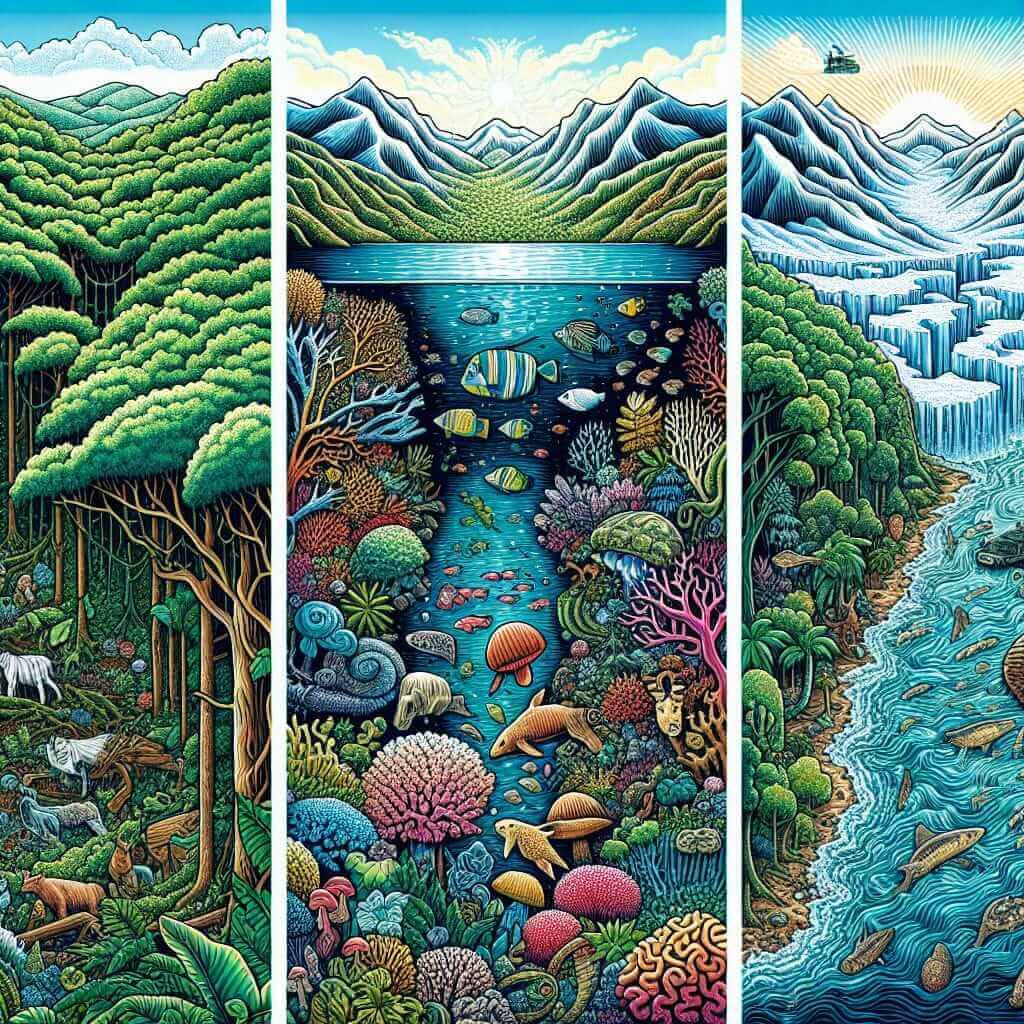The IELTS Reading test assesses a wide range of reading skills, including reading for gist, understanding logical argument, and recognizing writers’ opinions, attitudes, and purpose. One recurring theme in the IELTS Reading section is environmental issues, particularly climate change and its impact on biodiversity. Given the increasing relevance of this topic, it is prudent to prepare for such themes.
In this article, we’ll delve into “Effects of Climate Change on Biodiversity Hotspots”, providing practice material akin to the IELTS Reading test. This theme is not only timely but also recurrent based on past exam patterns. Understanding its intricacies will undoubtedly enhance your preparation.
Main Content
Reading Passage
Effects of Climate Change on Biodiversity Hotspots
Climate change poses significant threats to biodiversity, particularly in hotspots where ecosystems are most vulnerable. These hotspots are regions with extraordinary biodiversity, yet they face extreme pressures from anthropogenic changes.
Biomes such as tropical rainforests, coral reefs, and mountain ecosystems are prime examples. The alteration in temperature and precipitation patterns, coupled with increased frequency of extreme weather events, are driving many species towards extinction. For example, amphibians in the rainforests of Central America are drastically affected by changing climatic conditions, causing shifts in their breeding patterns and habitats.
Moreover, the coral reefs, often referred to as the “rainforests of the sea”, suffer from coral bleaching due to rising sea temperatures. The symbiotic relationship between corals and zooxanthellae is disrupted, leading to the expulsion of these algae that give corals their color and energy.
Similarly, mountain ecosystems show dramatic changes. As temperatures rise, species are forced to migrate to higher altitudes. However, this upward migration faces an inevitable limit—mountain summits. Consequently, many species may find themselves without a suitable habitat.
Human activities exacerbate these issues. Land-use change, pollution, and invasive species compound the effects of climate change, amplifying the risks to these critical habitats. The loss of biodiversity in these hotspots is not merely an ecological concern but also has profound socioeconomic impacts, affecting tourism, agriculture, and local communities dependent on these ecosystems.
Questions
Multiple Choice
-
Which ecosystems are primarily discussed as being impacted by climate change in the passage?
- A. Deserts, polar regions, and urban areas
- B. Tropical rainforests, coral reefs, and mountain ecosystems
- C. Grasslands, wetlands, and savannas
- D. Tundras, mangroves, and boreal forests
-
What is one effect of climate change on amphibians in Central America’s rainforests?
- A. Increased population growth
- B. Shifts in breeding patterns and habitats
- C. Improved resistance to diseases
- D. Decreased food supply
True/False/Not Given
-
Coral reefs are also known as the “rainforests of the sea”.
- True
- False
- Not Given
-
Land-use change has a minimal impact on biodiversity hotspots.
- True
- False
- Not Given
Matching Headings
- Match the correct description to the following paragraphs from the passage:
- Paragraph A: Changes in Mountain Ecosystems
- Paragraph B: Impact on Coral Reefs
- Paragraph C: Threats to Tropical Rainforests
Answer Key
Multiple Choice
- B. Tropical rainforests, coral reefs, and mountain ecosystems
- B. Shifts in breeding patterns and habitats
True/False/Not Given
- True
- False
Matching Headings
- Paragraph A: Changes in Mountain Ecosystems
- Paragraph B: Impact on Coral Reefs
- Paragraph C: Threats to Tropical Rainforests

Common Mistakes
- Misinterpreting Questions: Always ensure you understand the question correctly before looking for the answer in the passage.
- Overlooking Keywords: Keywords in the questions often match information in the passage, which can help in locating the answer more efficiently.
- Time Management: Allocate time wisely to avoid spending too long on one question and rushing through others.
Vocabulary
- Biome (noun) /ˈbaɪ.oʊm/: A large naturally occurring community of flora and fauna occupying a major habitat.
- Symbiotic (adjective) /ˌsɪm.baɪˈɒt.ɪk/: Involving interaction between two different organisms living in close physical association.
- Anthropogenic (adjective) /ˌæn.θrə.pəˈdʒen.ɪk/: Originating in human activity.
- Extinction (noun) /ɪkˈstɪŋk.ʃən/: The state or process of a species, family, or larger group being or becoming extinct.
Grammar Points
- Passive Voice: Used to highlight actions done to the subject, e.g., “are driven” in “are driving many species towards extinction.”
- Complex Sentences: Enhance understanding by connecting multiple ideas, e.g., “As temperatures rise, species are forced to migrate to higher altitudes; however, this faces an inevitable limit—mountain summits.”
Advice for High Reading Scores
- Practice Regularly: Regular practice with IELTS reading passages helps in improving speed and accuracy.
- Enhance Vocabulary: A strong vocabulary will aid in understanding complex texts.
- Skimming and Scanning: Develop skills in skimming for general ideas and scanning for specific details.
- Paraphrasing: Practice paraphrasing sentences to better understand their meaning and to help with question-answer accuracy.
By incorporating these tips and practicing with the provided reading passage and questions, learners can enhance their skills and increase their chances of achieving a high score in the IELTS Reading test.